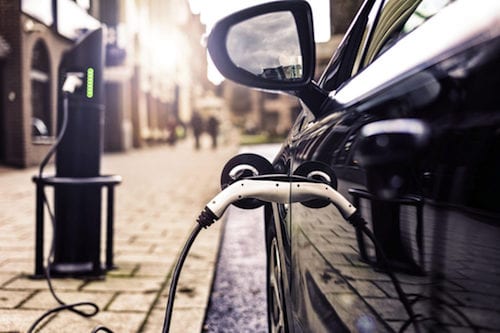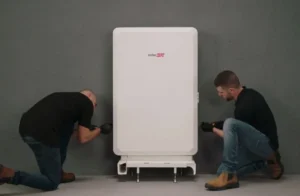
In a recent report and Politico op-ed, Jonathan Lesser of the Manhattan Institute purports to demonstrate that replacing internal combustion vehicles (ICVs) with zero emissions vehicles (ZEVs) will increase air pollution while having a negligible effect on climate change.
This has sparked controversy by many within the electric vehicle industry—and the energy industry more broadly—because the research is demonstrably false.
Conclusions are reached through misrepresentation and reliance on projections that are known to be consistently inaccurate. The same poor methods are applied to the economics of electric vehicles (EVs) and to questions about the profitability of, and public investment in, EV charging infrastructure.
Nonpartisan institutions, including the Union of Concerned Scientists and the Electric Power Research Institute, have published accurate and reliable studies of these questions that found the opposite of what Lesser concludes, as have others cited by the Energy and Policy Institute.
While those studies stand on their own merits, Rocky Mountain Institute (RMI) analysed this report and rebut inaccuracies here.
Lesser writes in his Manhattan Institute report that through 2050, “the net reduction in CO2 emissions provided by ZEVs is 896 million tons,” but then concludes that this nearly 1 billion tons of reduced CO2 “will have no impact on climate and, hence, no economic benefit.”
The social cost of carbon is, in fact, well studied and easy to express in monetary terms. Lesser does not do so, but he does meticulously quantify the monetary damages associated with other pollutants—SO2, NOX, and particulate matter—for which ZEVs are supposedly worse than ICVs.
He calculated the damages associated with those other pollutants using a flawed methodology and flawed assumptions, as explained below and as noted by CleanTechnica.
His report then concludes that “total damages from SO2, NOX, and particulates associated with ZEVs are $2.84 billion (2017$), while damages from the same number of ICVs… would total $801 million (2017$),” a net difference of over $2 billion.
Lesser’s analysis ignores the associated monetary damages of CO2 emissions (i.e., the social cost of carbon). In other words, Lesser cherry-picked the pollutants that support his narrative (in this case, SO2, NOX, and PMs) and ignored the pollutant (CO2) that contradicts his narrative.
A methodology that accurately accounts for all emissions results in a dramatically different result.
The Size of EV’s Climate and Pollution Impact
Lesser grounds his analysis in the US Energy Information Administration’s (EIA’s) long-term forecasts for the number of new ZEVs through 2050, how much electricity they’d use, and how much pollution that electricity would generate.
But those EIA long-term forecasts are notoriously inaccurate, consistently underestimating renewables penetration and overestimating grid emissions.
As noted by CleanTechnica and The Guardian, it’s apparent that these estimates, based on EIA’s Annual Energy Outlook (AEO) reference case for both ZEV penetration and the mix of electricity generation sources, will nearly certainly overestimate ZEV emissions.
As an example, the 2014 AEO noted that, in the 12 months between 2011 and 2012, solar and wind capacity grew by 137 percent and 27 percent respectively, but projected that in the five years between 2020 and 2025, they would grow by only 0.8 percent and 0.04 percent respectively.
By 2017, actual wind capacity had already exceeded the 2014 AEO’s projection for 2025, while actual solar capacity was already more than triple the projection for 2025.
Lesser relied on AEO projections of CO2 emissions for the coming 32 years. But the AEO’s projections over just the most recent 22 years (for 2015, the latest year for which actual figures are available) were, on average, 20.4 percent too high for energy-related CO2 emissions, and 42.7 percent too high for coal consumption.
In other words, using AEO projections to determine how much CO2, SO2, NOX, and particulates that the US electricity system will produce in the coming years will result in a significant overestimation.
A model developed by the Electric Power Research Institute (EPRI) has predicted actual average emissions intensity over the last decade far more accurately.
EPRI’s model predicts a 29 percent reduction in grid emissions intensity by 2030, while the AEO predicts it will be almost unchanged. As noted by Politico itself in 2015, given rapid coal plant retirements and the record-low prices for both wind and solar generation, the AEO scenarios seem implausible.
A recent EPRI report concludes that widespread adoption of electric vehicles, combined with a continued move toward cleaner electricity generation, will lead to modest decreases in particulates and ozone precursors, and to deep reductions in greenhouse gas emissions.
An even more thorough cradle-to-grave analysis by the Union of Concerned Scientists found that EVs “produce less than half the global warming emissions of comparable gasoline-powered vehicles, even when the higher emissions associated with BEV [battery-electric vehicle] manufacturing are taken into consideration.”
Even if we take Lesser’s numbers at face value, his report asserts that we should ignore roughly 1 billion avoided tons of CO2 because “this reduction is small.” (For reference, 1 billion tons of CO2 is the amount of CO2 removed by 25.6 billion urban trees over a 10-year lifetime or the CO2 sequestered in one year by an average US forest six times the size of Texas.)
Which leads one to wonder: What amount of CO2 emissions would Lesser characterizse as significant?
We were unable to reproduce Lesser’s analysis primarily because he combines emissions from petroleum refining with those from ICV operations without presenting the separate values for independent verification.
Therefore, we used this methodology to compare reductions in CO2 emissions drawn from the EIA and EPRI projections for both CO2 emissions from electricity generation and ZEV adoption.
This comparative analysis showed that from 2016 to 2050, reductions in CO2 emissions from ZEVs would be four times greater than the reductions projected using Lesser’s assumptions.
Accounting for the Social Cost of Carbon
Let’s dispense with the report’s argument that we do not need to consider the costs or benefits associated with 1 billion tons of CO2 reductions.
We considered a range of values for the social cost of CO2. The lowest value we found is $11 per ton, as calculated by the EPA (taken from a cached version of the EPA website from January 2017 because the current administration removed it from public view), while the Proceedings of the National Academy of Sciences estimates $31 per ton (in 2010$), MIT examined four estimates with a central value of $21 per ton, and others have estimated upwards of $220 per ton.
We apply a conservative range of values for the social cost of carbon of $11–$31 per ton (assuming a 3 percent discount rate) to the 1 billion tons of CO2reductions obtained using Lesser’s assumption.
This calculation yields monetary benefits from $4 billion to $11.2 billion, dwarfing the monetary damages from SO2, NOX, and PMs combined, calculated by Lesser to be $2 billion.
Using our own comparative analysis based on more realistic ZEV sales projections and renewable grid penetration, the range of monetary benefits would be $15.5 billion to $43.5 billion.
EV Economics in States with High Electricity Prices
The report states that a key barrier to broad-based adoption of ZEVs is that the cost of ZEVs charging from a high-renewables grid reduces the fuel savings of ZEVs relative to ICVs because “states with the most stringent renewable portfolio standard (RPS) mandates also have the highest average retail electricity prices,” and that “higher electric prices reduce the ‘fuel’ savings of ZEVs relative to ICVs.”
Lesser notes that the range of 2017 average electricity prices in some of these states (e.g., California, New York, New England states) are more than $0.18/kWh—high compared to a national average of $0.1225/kWh. Lesser omits proper context, however, by not including the equivalent $/mile cost of gasoline and converting $/kWh to $/electric-mile equivalent.
Using Lesser’s average ZEV efficiency for model year 2018 (0.28 kWh/mile) and the highest-cost electricity noted above ($0.1893/kWh in New England), the cost for electricity-as-fuel is $0.053/mile. Compare this to results from RMI’s recent Gas to Gridreport: the most recent range of cost per mile for gasoline is between $0.09/mile and $0.13/mile.
RMI’s report shows that the range of charging costs per mile for electricity-as-fuel is between $0.03/mile and $0.09/mile (for non-fast charging infrastructure). Gasoline would have to cost close to $1/gallon before an average 2018 ICV would cost as little to fuel as an EV.
Therefore, fueling EVs on even the highest-priced grids costs roughly half as much as the lowest estimated cost of fueling gasoline-powered ICVs.
EV Charging Infrastructure Costs—Who Pays?
It is also worth rebutting many of Lesser’s assertions about the shared costs of EV charging infrastructure. It is curious that Lesser begins his analysis by noting that public dollars go toward a 30 percent tax credit on EV charging stations, estimating a total cost for these credits at $155 million through 2016.
Later however, his analysis of the costs of a nationwide charging infrastructure notes only the total cost, making no effort to distinguish between costs covered by a tax credit, costs covered through utility investments, and costs covered by other means, such as municipal or state incentives, the private sector, and private citizens—leaving the reader with the distinct impression that these full costs will be borne by taxpayers and utility customers.
However, this depiction of the current reality leaves out important information about who is bearing those costs, and who can reasonably be expected to bear them in the near future.
According to RMI’s Gas to Grid report, “with the exception of Tesla… EV buyers and a few charging companies are making nearly all of the investment needed to keep vehicle electrification moving forward… Utilities and automakers other than Tesla are arguably not bearing a… share of the investment risk,” so utility customers are not bearing the brunt of these costs.
In cases where utilities are investing in electric vehicle supply equipment (EVSE), Lesser argues that most EV drivers and users are wealthy, while the costs incurred by utilities disproportionately fall on lower-income families.
We argue in Gas to Grid that, “the issue isn’t about cost-shifting so much as it is about timing. When nearly all drivers have EVs, the cost of charging infrastructure will be appropriately distributed among them” and “the real question isn’t about equity, but rather about who will provide the financing to build the infrastructure while the market matures… [until the] utilisation rate of the charging infrastructure should make a reasonable business case possible for owning and operating it.”
This is how similar conundrums have been handled in America’s recent past. Take, for instance, the “principle of line extension, in which all customers pay for extending the distribution grid, including new service for rural customers where the cost of providing that service is far greater than that for customers living in densely populated urban environments.”
This is a crucial nuance that we noted in Gas to Grid: EVSE “costs would only be shifted [onto taxpayers and utility customers] during the first part of the [EV] adoption curve. Once owning and operating charging stations is a sustainably profitable business in its own right, the need for public investment would be minimal.”
Profitability of charging services is directly linked to the utilization rate of the chargers, which is a function of the number of EVs on the road. Thus, any considerations of the costs of EVSE borne by the public will be heavily dependent on the choice of projections for ZEV adoption rates.
Just as the EIA projections that Lesser used for grid mix are demonstrably conservative, the EIA ZEV sales projections that Lesser used are some of the lowest available, implying that public investment will be needed to support EVSE for a longer time than other projections—for example, Bloomberg New Energy Finance’s 2018 Electric Vehicle Outlook—would indicate.
Lesser also argues that because of this allocation of costs across utilities’ customer bases, increased rates will disproportionately impact lower-income utility customers. We certainly don’t disagree with Lesser when he notes that most of the subsidies for EVs and EVSE are accruing to wealthier families.
But this should not be viewed as an argument to end those subsidies, but rather to more appropriately design them. As noted in Gas to Grid, if “regulators see a need to protect low-income and rural households from the shared costs of building charging infrastructure while the market matures, rebates or other cost-relief mechanisms should be preferred to avoiding any public investment whatsoever.”
We also acknowledge the very real equity and access issues associated with families living in multiunit housing complexes. However, this particular point of Lesser’s is also not a compelling argument to do away with EV subsidies.
Rather, this is a technology and business model challenge that requires the private sector (in partnership with utilities) to innovate. Further, solving these challenges will open up a huge market segment. In a recent report, Bloomberg New Energy Finance projects significantly more EV sales than EIA does, while limiting the addressable market to single-family households.
If new business models can expand ZEV access for residents of multiunit dwellings (who represent 20.7 percent of the US population), EV adoption will grow even more quickly.
Lastly, the report argues that EVSE and ZEV adoption will only result in enormous costs for utility customers. This ignores analyses by M.J. Bradley & Associates in multiple states, and a study by Energy+Environmental Economics, all of which predict significant downward pressure on electric rates from widespread ZEV adoption.
ZEVs have the potential to provide considerable benefits to the grid (e.g., demand flexibility, frequency regulation) and as a result, lower the cost of electricity. The benefits to utility customers are greatest when a utility adopts time-of-use pricing for EV charging, encouraging customers to do most of their charging at night when there is excess generating capacity available on the grid.
In this way, a utility collects more revenue from electricity sales than the incremental cost of serving the load, thus generating net revenue. Under the rules of most state utility regulators, the bulk of such savings accrue to utility customers in the form of lower rates.
EV Subsidies in Proper Context
In addition to the flaws in Lesser’s analysis and methodology, his report is deceptive in the way that it presents the value of EV and EVSE subsidies and costs without proper context.
What a casual reader might see as eye-poppingly large values when presented in total and out of context are significantly less so when viewed as costs paid out over time or in comparison with other taxpayer subsidies—for example, those for oil and gas extraction.
Lesser calculates that, during the period 2011–2017, $4.7 billion in tax credits have been used to subsidize EV sales, equivalent to $670 million per year. Lesser estimates the grand total of all subsequent subsidies on sales will be between $13 billion and $20.9 billion (not including the $4.7 billion already paid out), though these will also be amortized over many years.
Using Lesser’s figures, it took from 2011 to 2017 for the EV industry to sell 722,806 vehicles across the 14 original equipment manufacturers (OEMs) that Lesser evaluates. The industry is at the early part of the adoption S-curve and it is difficult to project when adoption will become more rapid.
But even with solid year-over-year growth, we might expect it to take several years to reach the point where most OEMs have met the 200,000 sales that would trigger the credit expiration.
Even using an aggressive assumption that every OEM will meet this sales goal and all credits will expire in only five years, the subsidies would amount to between $2.6 billion and $4.18 billion annually, comparable to or less than the annual federal taxpayer subsidy of $4 billion provided to the oil and gas industry.
A similar amortization of EVSE infrastructure costs would considerably reduce the sticker shock associated with Lesser’s estimated $84 billion required to install 600,000 Level-2 chargers nationwide.
EVs Are Not Bad—In Fact, They’re Incredibly Beneficial
Lesser’s analysis relies on projections that are recognized to be conservative; it ignores the positive carbon benefits of ZEVs; it misrepresents EVSE infrastructure investments; and it fails to provide adequate context so that ZEV subsidies, costs, and impacts may be compared to the status quo.
At RMI, we believe that regardless of how you tweak the analysis or which projections you choose, ZEVs offer significant positive benefits in all scenarios.
That’s why we’ll continue to collaborate with the industry to drive a shared, electric, and autonomous mobility future that is better for the planet, and the people on it.
Source: RMI. Reproduced with permission.







